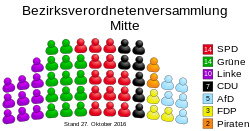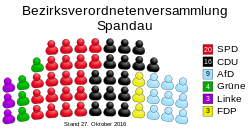District of Berlin
According to the constitution of Berlin, a district of Berlin has neither the status of a district , since Berlin is an independent city , nor a municipality , since Berlin is a unitary municipality . It is a "self-governing unit of Berlin without legal personality " (Section 2 (1) District Administration Act ). Berlin is divided into twelve districts.
District administrations
The district administrations form the lower part of the two-tier public administration of the German capital Berlin and stand for the self-administration of the twelve Berlin districts. Organs of the district administration are the district council assemblies (BVV) and the district offices (BA). The district administrations are primarily responsible for matters on site in the districts, such as culture, green spaces or schools.
The district self-government has constitutional status (Articles 68–77 of the Berlin Constitution ). It is divided into two administrative bodies, the District Assembly (BVV) and the District Office (BA). BVV than directly by the inhabitants of the district elected representatives ( parliament ) of the "parliamentary" part, the district office leads the administration. Each district office consists of the district mayor (full-time, paid according to the B6 federal salary regulations ) and four district councilors (paid according to the B4 federal salary regulations ).
The last major change came with the Territorial Reform Act, which in 2001 merged the 23 districts that had grown historically into 12 districts of similar size.
With the 8th law amending the District Administration Act of October 22, 2008, which does not come into force until the beginning of the 17th electoral term, all district offices should be uniformly structured in the same specialist offices. Various previous specialist offices have been combined to form larger organizational units; there should then only be ten specialist offices per district administration.
Election of the district office
The district office is elected by the district council at the beginning of an electoral period. In principle, the right to propose the election of the district mayor belongs to the strongest parliamentary group , but can be transferred to a so-called counting community made up of two or more parliamentary groups, which must have more mandates than the strongest parliamentary group. The district office is composed of candidates proposed by the various parliamentary groups and elected by the BVV , in proportion to the district election result . A district city councilor can be voted out of office with two thirds of the BVV's votes before the end of the electoral term. The right to propose this city council post remains with the sending parliamentary group as long as the majority structure has not changed due to a change of parliamentary group .
A change in the electoral mode and the introduction of the so-called political district office was long in Art. 99 a. F. of the Constitution for January 1, 2010. After all, it did not come into force.
Division of departments
After the district office has been elected, it decides on the layout and distribution of the individual departments among the district councilors. As a rule, this division of responsibilities is agreed between the parliamentary groups before the district office is elected; however, the district office is not bound by this. The city councils manage their departments on their own responsibility. The position of the district mayor, who is also the district councilor, can be described as primus inter pares . In the event of differences of opinion, the district office decides with a majority; in the event of a tie, the district mayor's vote counts twice. The work of the district office is controlled by the BVV.
The district office, which is to be elected by the BVV, consists of five members: the district mayor and four district councilors. The nomination rights for the district office positions are distributed proportionally to the district election results according to the d'Hondt'schen maximum number method among the parliamentary groups of the district council assemblies. The district office members are elected by the BVV - at least legally - independently of later areas of responsibility. Which district office member is later responsible for which departments is determined by the district office on its own responsibility by majority vote.
District Assembly
The district council assembly (BVV) consists of a maximum of 55 district councilors . The BVV is headed by the board elected from within its own ranks, consisting of the head of the district council, a deputy and other assessors. At the beginning of an electoral period, the BVV issues rules of procedure and elects the district office. District councilors are often wrongly referred to as MPs .
The BVV election is purely a list election . In contrast to the elections for the Berlin House of Representatives and the Bundestag, those entitled to vote only have one vote with which they can elect an electoral association or party. Individual candidates are not possible. In order to be elected as a district councilor, one must have the right to stand as a candidate, be resident in Berlin, have EU citizenship and have been put on an electoral list .
The parties established in Berlin ( SPD , CDU , Die Linke , Bündnis 90 / Die Grünen , AfD , Piratenpartei , FDP ) or local electoral communities compete in the BVV elections and make so-called election proposals in the form of candidate lists. There are no direct mandates, so there are no overhang or compensatory mandates. In some BVVs, smaller parties are also represented, since the 2006 elections, the gray ones are or have been in eight of the twelve district council assemblies, the WASG in seven, the NPD in four and the Republicans in one.
In the elections on September 18, 2011 , the Pirate Party , which stood for the first time in the BVV election, entered all twelve district council meetings, in some cases with double-digit results. Due to the low number of nominees nominated and the simultaneous election of some candidates to the House of Representatives , the Pirate Party was unable to occupy all its seats. According to the election , the BVV had only 54 in each of the districts of Mitte , Spandau , Marzahn-Hellersdorf and Treptow-Köpenick and only 51 instead of 55 in the Friedrichshain-Kreuzberg district. As of August 13, 2012, BVV Mitte consisted of only 53 ordinaries, as one of the five district councilors for pirates gave up their post.
The AfD has been represented in all districts of Berlin since it first appeared in the elections on September 18, 2016 . The party was able to provide city councils in seven districts and in the Marzahn-Hellersdorf district it was even the second strongest force. The AfD was able to fill all the seats it won in the district parliaments with candidates.
The elected candidates on a list drawn up for the BVV election form a parliamentary group in the BVV. At least three (otherwise non-attached) district councilors who belong to the same party can form a parliamentary group, and two non-attached members form a so-called group (this option is not available in all districts, however). Members of different parties can only belong to one parliamentary group together if they are elected on the same list.
District councilors work on a voluntary basis and receive an expense allowance amounting to 15% of the diet of a member of the Berlin House of Representatives. The amount is rounded down until it is fully divisible by five. For a diet of 3742 euros, the basic compensation is 560 euros. In addition, there are attendance fees (20 euros per parliamentary group or committee meeting and meetings of the councils of elders, 31 euros for a plenary meeting) and a fare allowance of 41 euros per month. For their prominent function and the associated additional time expenditure, the parliamentary group chairmen receive double the basic compensation, the BVV head 3.5 times and the deputies of the district councilors 1.5 times the basic remuneration.
The mandate of district councilors ends at the end of the electoral term, otherwise through resignation, withdrawal or death. In addition, the mandate automatically expires if a district councilor is elected district mayor or district councilor, moves into the Berlin House of Representatives or moves away from Berlin.
According to the Berlin Constitution (Articles 69–73), BVV is the “organ of district self-government”. She elects the district office. Your task is to control the district administration . It also decides on the district budget , which, however, requires the approval of the House of Representatives. In addition, the BVV can hardly pass resolutions that the administration would then have to implement (whether and how it does this is a matter for the administration). It can question the district office (e.g. small inquiry, large inquiry, verbal inquiry ) and initiate administrative action via requests and recommendations to the district office; she has no right of instruction.
BVV sets for their work committees one, which in addition to the district council also Bürgerdeputierte may belong, who are elected on factional proposal from the BVV.
choice
The BVV electoral term is linked to the legislative term of the House of Representatives. It is therefore five years, but ends automatically in the event of an early dissolution of the House of Representatives (as in 2001). An exception to this was the 1990 election, when only the House of Representatives was re-elected in the course of the reunification of the city. In 1992 there were only elections to the BVVs.
In addition to German citizens, citizens of other EU member states with a registered place of residence in Berlin are also entitled to vote in the elections to the BVV . The minimum voting age has been 16 years since October 2005. While there is a threshold clause of 5 percent in the House of Representatives elections, this was declared unconstitutional for the BVV elections by a ruling by the Berlin State Constitutional Court. A 3 percent hurdle was then introduced.
Distribution of seats
The graphics visualize the number of seats after the election, but not necessarily how the district councilors actually sit. The changes in the composition since the 2016 election are reflected in the graphics.

|

|

|

|

|

|

|

|

|

|

|

|
See also
Web links
- District Administration Act (BzVwG) gesetze.berlin.de, completely on a single page.
- Interesting facts about the district council meeting berlin.de/ba-steglitz-zehlendorf, accessed on October 15, 2011
Individual evidence
- ↑ piratenfraktion-berlin-mitte.de ( Memento from June 30, 2015 in the Internet Archive ) Blog of the BVV Piratenfraktion Mitte
- ^ Uwe Aulich: BVV election: AfD makes it into all of Berlin's district parliaments . In: Berliner Zeitung . ( berliner-zeitung.de [accessed October 17, 2018]).
- ↑ gesetze.berlin.de Section 3 (1) BzVwG, November 1, 2011
- ↑ Law on the compensation of the members of the district council assemblies, citizens' deputies and other voluntary persons ( Memento of March 4, 2016 in the Internet Archive ) (PDF) as of December 18, 2013
- ↑ Diets (parliamentary allowance). parlament-berlin.de, accessed on June 27, 2015.
- ↑ expense allowance . ( Memento from June 30, 2015 in the Internet Archive ) Pirate faction Berlin Mitte; accessed on June 27, 2015.
